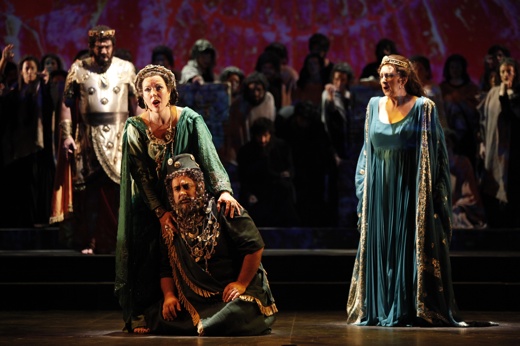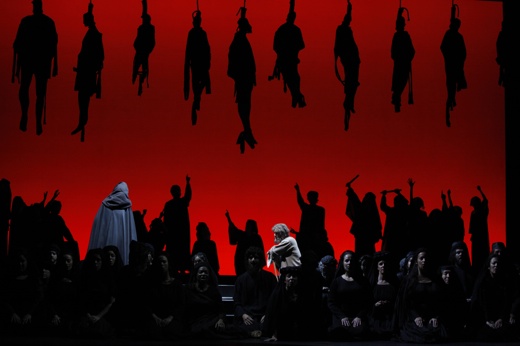
Doubling down on its artistic mission, New York City Opera begins a tenuous season with a turgid Bible drama.

Stephen Kechulius (Xerxes), Margaret Thompson (Zeresh), Roy Cornelius Smith (Haman) and Lauren Flanigan (Esther) in the New York City Opera's caftan-rich production of Weisgall's "Esther." Photo: Carol Rosegg.
It was a time of tightening belts for City Opera. They spent the summer grappling with a deficit, renegotiating union contracts, and scaling back production costs. Sound familiar? It was 1993. Hugo Weisgall’s Esther was co-commissioned with San Franscisco Opera for the spectacularly ambitious 1992 season that included 108 performances of fourteen different operas. After San Francisco backed out, it was finally premiered in New York in October of 1993, amid fiscal crunch.
Fast forward, through the Golden Years, to 2009. Coming to the rescue in a downward spiral, George Steel has turned to Esther to remind audiences of New York City Opera’s mission, which if you don’t remember, is to be a catalyst for new American operas, to present works outside the standard repertoire, and to nurture young talent. After a dark year for theater renovation work, a troubled succession of artistic directors, and a painful summer budget crisis that will doubtless have a long impact, they are being challenged to justify their very existence.
In spite of these woes, the audience was primed for pleasure as it strode into the newly renovated former New York State Theater on Saturday night. Its transformation into the “David H. Koch Theater” means plush red carpeting, a beautiful new ironwork proscenium and front curtain, space-age backlit wall paneling, and business-class seats. Oohs and ahhs were audible everywhere.
Esther did little to reward this good will. The opera comes across not so much as modern or challenging, but frustrating and tedious. For all its angular, uncompromisingly atonal musical materials, Esther is a deeply conservative work. Written for a modest-sized (roughly Tchaikovskian) orchestra and very reasonable staging demands, it was evidently composed with the hope that it might become a repertory piece. Weisgall may have fared better as an orchestral composer, and Esther might have fared better as an orchestral work without voices or plot – though the vocal writing is idiomatic and humane, the work is a colorful and daring display of orchestral acrobatics, with the inconvenience being that it is a work for the stage.
The story (familiar if you were a regular attendee at Bible school) tells of Esther, a Jew, who is chosen to become the bride of King Xerxes, then capitalizes on his affection for her to rescue her people from extinction. The dichotomy of the jealous, deposed Queen Vashti and Esther, an infiltrator of the royal court, as well as Esther’s “negotiation” scene with Xerxes, in which he offers her carte blanche, invite rather unfortunate comparisons with Aïda and Salome, respectively.
Unfortunately, Aïda + Salome ≠ Esther. The stage business borrows much from stock Grand Opera, revenge tragedy, and historical pageant, as if Weisgall would hedge his bets on immortality: If it looks like Nabucco, but I can’t hum a note of it, it must be a Modern Masterpiece!
For decades, New York composers north of SoHo were held in thrall by a delusion that Serialism was the final word on serious composition. By the 1990s, most had woken up. Esther sounds like an opera written thirty or forty years earlier than it was, and is reminiscent of the musical language of Britten’s War Requiem, 1960s Martha Graham ballets, Stravinsky’s Agon, Copland’s confused, dissonant middle period, and Samuel Barber’s less lyrical strokes.
This is not to say Esther belongs in the same category. In Lulu and Wozzeck, Alban Berg softened atonality’s effect by using serial technique as a means of constructing pseudo-Leitmotivs that aid in the development of characters and dramatic continuity. In Esther, Weisgall gives the poor listener hardly a single recurring motive. And where composers like Berg, Britten, and Barber (with whom Weisgall shared an early teacher, Rosario Scalero at the Curtis Institute) had a way of setting text idiomatically regardless of the musical idiom, Weisgall’s work is an awkward and matter-of-fact arrangement of text upon jagged musical gestures. (The prosaic libretto, wordy and all plot, is by Charles Kondek.)
While setting voices to music remains the most elusive art form, the composers who define our age in 2009 seem better skilled at the compromises necessary to connect “art music”, which insists on a kind of specialized musical rhetoric, with the sort of entertainment that welcomes audiences.
Lauren Flanigan (Esther) and James Maddalena (Mordecai) are both stalwart interpreters of this kind of repertoire, blessed and cursed to be in constant demand for roles in American contemporary operas because of their rare technical prowess and musical versatility. Ms. Flanigan sang the premiere production here in 1993. Reprising the role after sixteen years, her voice astonishingly retains a girlish quality perfect for the teen queen, and she sang with ease and attractively colored sound through a maze of technical feats. Maddalena was sympathetic in the “Amonasro” role of Esther’s uncle Mordecai, singing some of the less jerky vocal writing found in this opera with warm, shapely lyricism. Xerxes was well suited to the darker baritone of Stephen Kechulius, who sang the part with gravitas.
Mezzo-soprano-to-watch Beth Clayton’s portrayal of Queen Vashti was a special delight. Her voice, though small, is darkly hued, velvety, and clear, and she made real music out of Vashti’s vengeful declamations. Haman, an unforgiving role full of bluster and blood thirst, was sung by Roy Cornelius Smith, a powerful tenor with a resonant middle register and metallic top, in his City Opera debut. Margaret Thomson, also in her debut, was bracing as Haman’s wife, Zeresh.
Comprimari were strong, but across the board somewhat green. So too, the countertenor Gerald Thompson (as a eunuch harem-keeper), though he sang with an appropriately innocent, airy quality. The choral writing, which has some of the lovelier bars in the piece, was delivered precisely and with devotion by the New York City Opera Chorus. The production, by Christopher Mattaliano, was all scrims and pattern light projections, which moved and changed frequently but had a “budget” look – appropriate, perhaps, under the circumstances. The costumes dated themselves worse than the staging, at times looking borrowed from an Otto Schenk Verdi production across the Plaza.
Approaching this work virtually anew after 16 years, the orchestra sounded not yet comfortable with the feat. Weisgall’s skill at keen, economical orchestration means a streamlined, restrained use of the orchestra, where grander statements may have had a better effect. The score is replete with virtuosic instrumental writing, including some very high and exposed solo horn licks, held down admirably by Stewart Rose. George Manahan pushed and pulled the ensemble through the tricky score, and managed not to let the seams show.
“It’s my job to make every night at NYC Opera as thrilling as it can be” says Steel, City Opera’s new General and Artistic Director in an interview reprinted in Saturday’s program. He has also said that, upon taking the reins at City Opera, Esther was one of the first pieces he wanted to revive. While these utterances may not be congruous from the perspective of many attendees on Saturday night, the current City Opera season should not be held too strongly against them. They are, in a time of uncertainty, rightly revisiting productions that put them on the map as an innovative and useful company, and doing well under the circumstances.
Misgivings about Esther notwithstanding, it says much about City Opera’s commitment to new works that they have brought it back for a second go. Audiences change over the course of 16 years – some works may resonate better the second time around, and some may sour. To accept a certain degree of risk is an important part of the creative process. The fact that City Opera understands this is precisely what makes them unique and necessary, not just for New York City, but for the climate of opera in this country.

























Comments